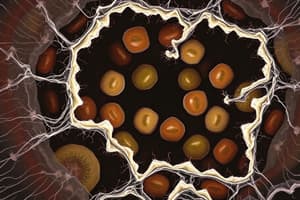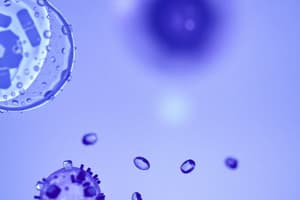Podcast
Questions and Answers
What role does the cell membrane play in relation to the cell?
What role does the cell membrane play in relation to the cell?
- It supports the cell structure independently of movement.
- It allows the exchange of genetic material.
- It provides energy for cellular activities.
- It controls the movement of substances into and out of the cell. (correct)
Which statement accurately describes mitochondria?
Which statement accurately describes mitochondria?
- They are primarily involved in protein synthesis.
- They are visible with a light microscope in large numbers only in inactive cells.
- They are involved in respiration and energy release. (correct)
- Their structure is the primary site of photosynthesis.
What is the primary function of the cell wall in plant cells?
What is the primary function of the cell wall in plant cells?
- To determine the genetic characteristics of the plant.
- To store nutrients and waste materials.
- To provide shape and support while allowing substance permeability. (correct)
- To facilitate communication between cells.
How does the vacuole differ in plant cells compared to animal cells?
How does the vacuole differ in plant cells compared to animal cells?
Which organelle is essential for photosynthesis in plant cells?
Which organelle is essential for photosynthesis in plant cells?
What is typically found in the cytoplasm of a cell?
What is typically found in the cytoplasm of a cell?
Which of the following statements is true about chlorophyll?
Which of the following statements is true about chlorophyll?
What distinguishes active cells from inactive ones in terms of mitochondria?
What distinguishes active cells from inactive ones in terms of mitochondria?
What characteristic is unique to plant cells compared to animal cells?
What characteristic is unique to plant cells compared to animal cells?
Flashcards are hidden until you start studying
Study Notes
Cell Membrane
- Forms a boundary between the cell's interior and its environment.
- Regulates movement of substances in and out of the cell.
Cytoplasm
- Site of all cellular activities.
- Contains organelles like mitochondria and ribosomes, as well as food reserves (glycogen, starch, oil droplets).
- Appears granular in structure.
Mitochondrion
- Organelle where respiration occurs, providing energy for cellular functions.
- Active cells, such as liver cells, have numerous mitochondria.
- Structure is typically not clearly visible under light microscopy.
Cell Wall
- Nonliving layer external to the cell membrane in plant cells.
- Permits free passage of liquids and dissolved substances.
- Provides shape and structural support to plant cells.
- Absent in animal cells.
Vacuole
- Mature plant cells contain a large central vacuole filled with cell sap (dilute solution of salts and sugars).
- May also contain pigments.
- Animal cells may have small, temporary vacuoles.
Chloroplast
- Organelle that contains the green pigment chlorophyll found in plant cells.
- Abundant in palisade cells of leaves, where photosynthesis takes place.
- Not present in animal cells.
Studying That Suits You
Use AI to generate personalized quizzes and flashcards to suit your learning preferences.




